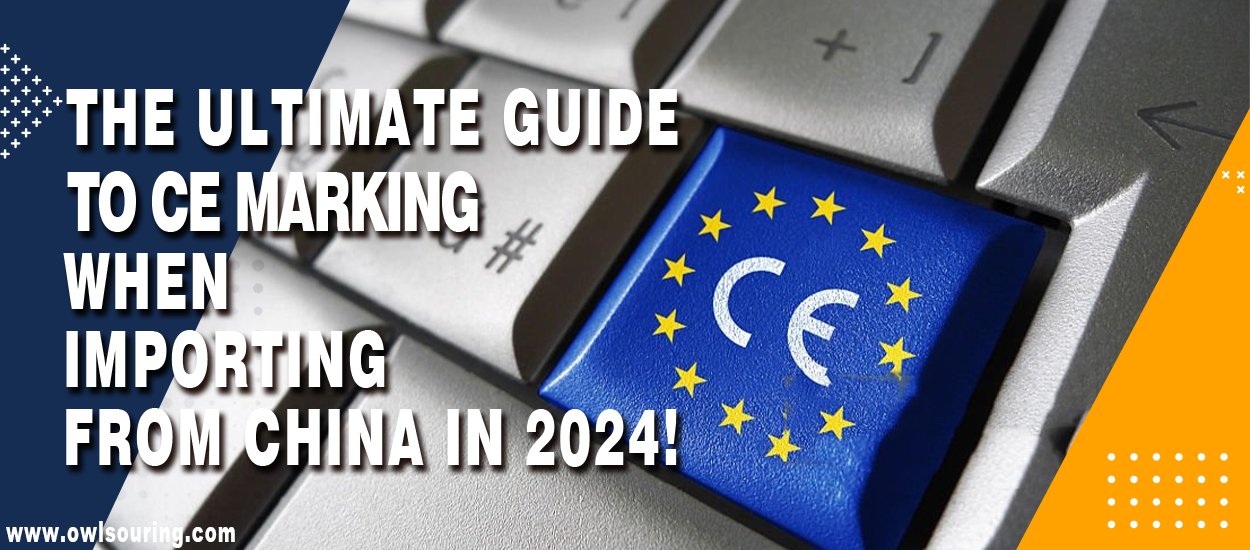You will find CE markings on many goods sold in the European Economic Area. This term is crucial if you are an importer buying goods from China and selling them in Europe.
The letters denote Conformité Européenne, which means European Conformity.
The CE marking is a symbol. It is essential to prove that products being sold in Europe have met all the standards. Simply put, it means a manufacturer’s declaration. The declaration says their product meets critical EU safety, health, and environmental rules.
So, what exactly does CE marking hold for importers? And how can you ensure your Chinese-made products meet these necessary European standards? Let’s find out!
CE Marking: What Does It Mean for Importers?
The CE marking shows the product meets the EU’s minimum safety rules. It ensures lower risks of the product harming its users or the environment.
This marking helps with the easy, free movement of said goods. It allows your products to move freely across the EEA. Your items can enter the market without any impediment, regardless of origin.
Notes:
- The CE marking signifies compliance with safety rules. But it doesn’t guarantee top quality or performance. Different products with CE markings may have varying quality levels.
- Manufacturers are responsible for ensuring their products follow EU directives. They also must put on the CE marking.
- Authorities may add a four-digit ID to the CE mark. It shows that a notified body has verified the product. These bodies are independent firms authorised by the EU.
- The CE marking’s specific requirements can change. They change over time as the EU updates its regulations.
You can read more about CE marking and its rules.
Importance of CE Marking When Importing from China

CE marking is crucial to importing products from China to the European market. Below, you can read its significance.
1) Legal Requirements for the EU Market
The EU operates under the principle of harmonisation. That means most products only need one set of rules for the entire market. It makes the process easier for businesses.
The General Product Safety Directive rule (2001/95/EC) is fundamental among them. It applies to products not covered by any specific EU directives. It still needs to be demonstrated as safe for consumers.
2) Priority on Safety and Environmental Standards
CE marking ensures products are safe for users. It also confirms that the imported goods are environmentally friendly. So, it is essential for items like toys and electronics.
In the long run, the CE marking ensures the products don’t harm people. It covers importing, selling, and using a product.
3) Brand Credibility and Customer Loyalty
Remember, quality control in China and the EU market can differ. You must balance both of them.
CE marking shows your commitment to quality and safety. It builds trust with your customers and grows your brand.
You can become a brand with a track record of selling premium products that meet EU regulations. So, this marketing will enhance your brand’s reputation in the EU market.
4) Product-Specific Requirements for Different Products
Different products have different CE marking requirements. That’s because some products, like machinery or electronics, have different effects. They differ from those in other categories, like clothing or home decor. The examples are as follows:
- The Toy Safety Directive ensures toys are safe for children.
- Electrical equipment having determined voltage ranges falls under the Low Voltage Directive (LVD).
- The EMC Directive prevents other electronic equipment from interfering with each other.
- The Machinery Directive covers safety for machinery.
Thus, you must identify which directives apply to your product.
Identifying Directives and Norms of CE Marking for Products from China

So, you know how to source products from China. But how can you sell them in a country with strict regulations?
Importers should have a thorough understanding of applicable EU directives. Knowing the correct norms can make the whole process straightforward.
Step 1: Relevant Guidelines on CM
First, determine which EU directives and standards apply to your product. The EU’s NANDO database can help with this. Check the database and ensure your product meets the standards that apply to it.
Step 2: Assessing whether the Product Complies with CM
Next, test your product to ensure it meets the required standards. Sometimes, you may need to contact an authority to make the assessment. It is an accredited organisation explicitly appointed for the evaluation.
Step 3: Technical Certifications and Documents
Create a technical file showing that your product complies with EU rules. This file includes:
| Components | Description |
| Product Details | The product should have a name and model number. It should also have an intended use and technical specifications. |
| Design and Manufacturing Information | This report contains details on the product’s design and production. It covers the materials, processes, and quality checks. |
| Risk Assessments | The company identified the potential hazards in the product. The measures it took to reduce those risks. |
| Test Reports | The document must show any tests on the product. These tests must demonstrate their compliance with EU directives. |
| User Manual | The user manual gives instructions for the safe use of the product. It also ensures the product is used for the given purpose. |
Step 4: Stamp up with a DoC
Once compliance is confirmed, you can put the CE mark on your product. You also need to issue a Declaration of Conformity (DoC). It includes product details and applicable directives.
Also, the manufacturer’s information is included. It has details of any notified body used and the signature of an authorised person.
Tips for Ensuring Compliance with CE Marking Regulations
You must specify compliance with CE marking regulations. Below are some essential tips to help you handle this crucial aspect.
1) Choose an Expert Consultant or Advisor
Hiring an expert in EU regulations can make the process easier and ensure you follow all rules. Get advice on better practices during the importation process. A qualified consultant makes your work easier.
2) Start Early in the Product Development Cycle
Begin the CE marking process early to avoid delays. Testing and documentation can help you find and fix issues early. You can handle minor problems before they become and affects compliance.
3) Invest in Thorough Testing and Certification
Proper testing and certification are crucial for safety and compliance. It can save you from future problems and improve product quality.
Best Practices to Get CE Marking When Importing from China

Selling your product in Europe can be exciting. But their regulations can feel overwhelming. Follow these practices.
1) Work With a Sourcing Agent
You can browse top Chinese wholesale websites to buy from China. However, hiring local experts in China is your primary need. They understand the rules of both China and the EU. They’ll be your on-the-ground allies.
Don’t settle for just any factory in China. Find experienced sourcing partners who understand international quality standards.
A specialised China sourcing service can ensure your product meets EU requirements. They can assist in several key ways:
- Identifying applicable directives for your specific product
- Vetting and choosing manufacturers with a track record of producing CE-compliant goods
- Handling quality control processes to ensure consistent compliance
- Managing communication between you and the manufacturer about technical specifications
- Arranging for necessary testing and documentation work to support CE marking
2) Use Tech Tools
Forget mountains of paperwork! Professional software can read through technical documents and track your compliance status. These tools keep you organised and make the process less stressful.
3) Bridge the Culture Gap
Remember, business customs can differ. Communicate with Chinese manufacturers and inform them about your CE marking needs.
4) Learn from the Best
Research companies that have successfully obtained the CE marking. You can analyse their experiences and strategies to avoid common issues. By learning from their wins, you can optimise your approach for a smooth EU market entry.
Read More:
- Import Electronics from China
- Basic Trade Terms Alibaba Incoterms
- How to Find the Best Toy Manufacturers in China?
- Top Strategies to Import Goods from China to France
- Importing Children’s Products from China: A Quality Guide
Final Thoughts!
Now, you know how businesses can handle the process of CE marking when importing from China.
Selling your product in Europe needs a strategic approach to expand your reach. However, dealing with the regulations takes a lot of work, especially regarding CE marking. We hope this guide has been your compass, pointing you in the right direction.
You can simplify the process by partnering with reliable Chinese manufacturers. Use local expertise and technology to your advantage. The involvement of an expert sourcing agent can significantly reduce the risk of non-compliance.
Our experts are actively involved in global sourcing. They know both Chinese manufacturing practices and EU regulations. So, we can bridge the gap between these two markets. Contact us! We will ensure your products meet CE marking rules so they can sell legally in European markets.



2 thoughts on “The Ultimate Guide to CE Marking When Importing from China”
I’ve been struggling with CE marking compliance for my electronic products. The guide seems helpful, but I’m particularly concerned about the ongoing monitoring requirements after the initial certification. please provide more specific guidance about electronic products.
Thank you for your comment! For ongoing CE marking compliance for electronic products, maintain up-to-date documentation, conduct regular tests, implement a robust quality control system, and stay informed about regulatory updates. These steps ensure your products continue to meet CE standards. If you need more specific guidance, feel free to reach out anytime!